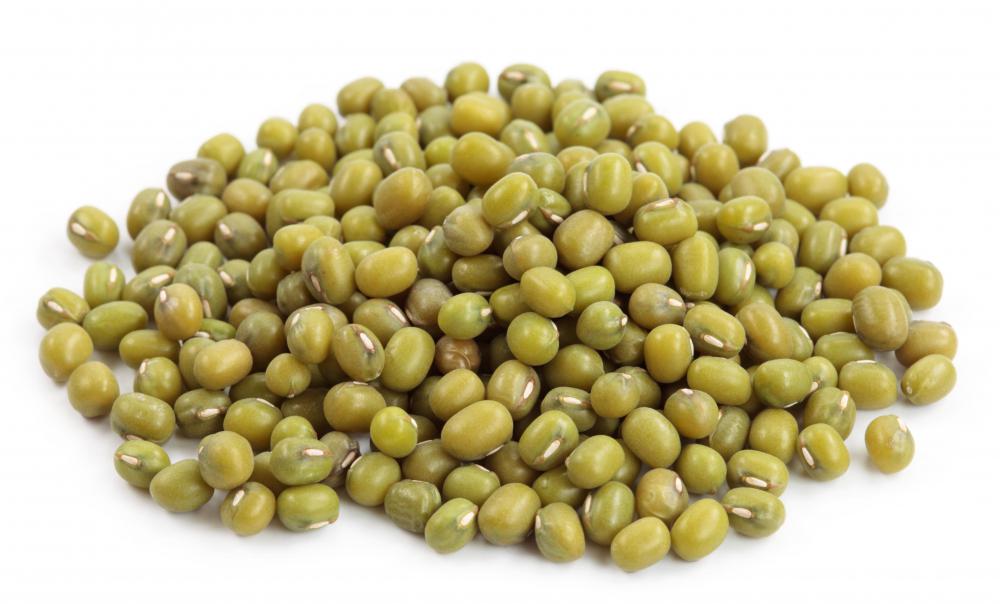At DelightedCooking, we're committed to delivering accurate, trustworthy information. Our expert-authored content is rigorously fact-checked and sourced from credible authorities. Discover how we uphold the highest standards in providing you with reliable knowledge.
How Do I Choose the Best Mung Beans?
Mung beans are small green or red beans from the Indian subcontinent, and are common in food throughout south and southeast Asia. The best mung beans are brightly colored, smooth and oval in shape, and without any cracks, soft spots or discoloration. These beans are usually sold dried, and should be even in size and shape, and dry throughout. When sold fresh, mung beans are slightly larger and softer and may be sold in their pods, which should be dry, brown, and papery. In cooking, mung beans can be boiled for consumption whole, sprouted, or made into noodles.
Most mung beans sold in North American grocery stores are green, but reddish-brown varieties are also available. Look for a consistent, relatively bright color and an undamaged skin. The bean should not be cracked or broken unless all of the beans have been split for soups. Avoid any specimens with discolored spots on their skins or a soft feel, as these may be rotten.

When buying dried mung beans, look for fresh, unwrinkled specimens about about 0.25 inch (0.5 cm) in length, without many stones or pieces of dirt in the bag. Avoid containers that include many broken or shrunken beans, as these may not cook evenly. One or two discolored beans is acceptable, but, if many beans seem to be light or faded, the container may have been stored poorly.

Fresh mung beans are rare outside of Asia, but may be found in small local markets, where they are frequently sold in the pod. The pods should be dry, light to medium brown, and easily broken. You can quickly shell the beans by crushing them and shaking the lighter pods away on a sieve. The beans themselves should be a slightly brighter color than the dried product, a little larger, and somewhat less dry, but specimens with dark, light, or soft spots should still be avoided.

Preparing mung beans requires a pot of boiling water or a sprouting jar. To boil these beans for use in soup or curry, first soak them for an hour or two, and then cook them until they begin to disintegrate. To sprout the beans, soak them in cool water for 8 to 12 hours, then place them in the sprouter out of direct sunlight. Rinse the beans once or twice a day for 2 to 6 days, depending on the desired sprout size. Ordinary dried beans may not sprout as well as beans guaranteed to germinate, but they tend to be less costly.
These beans originated in India, where they are commonly consumed in curries and soups, but they can also be found in Vietnam, the Philippines, and Indonesia, as well as in Thai, Japanese, and Korean cuisines. Cooks in Bangladesh, Burma, and Pakistan use these beans in dishes similar to those made in India.
AS FEATURED ON:
AS FEATURED ON:













Discussion Comments
@discographer-- Mung beans should be plump, even colored with tight skins. Stay away from wrinkly mung beans with color variations. This means they're old and beans from different batches were mixed together, so they won't cook evenly.
@discographer-- In my experience, fresh mung beans make the best bean sprouts. If you're buying your mung beans pre-packaged from the grocery store, they may be old. There is a packaging date on the bags but that's not necessarily when the beans were produced. So the beans might have waited for some time before they were packaged. Sometimes you can tell from the color, old beans tend to take on a dark, faded green color whereas fresh beans are a brighter green.
If you can find mung beans that you know were produced recently, that will be best. It's difficult to find unpackaged mung beans at stores, but some organic markets do have them. Those might be a safer bet.
I have nice green mung beans but it's difficult to make them sprout. I don't know if I'm doing something wrong or if it's because of the humid climate here. But every time I put mung beans in water to sprout, they go bad as soon as the sprouting starts. The sprouts never become full size and I'm forced to throw the whole thing away. It's very disappointing.
Could this be due to the mung beans?
Post your comments